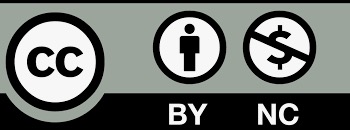Published
2024-01-03
Issue
Section
Research Articles
License
The journal adopts the Attribution-NonCommercial 4.0 International (CC BY-NC 4.0), which means that anyone can reuse and redistribute the materials for non-commercial purposes as long as you follow the license terms and the original source is properly cited.
Author(s) shall retain the copyright of their work and grant the Journal/Publisher rights for the first publication with the work concurrently licensed since 2023 Vol.8 No.2.
Under this license, author(s) will allow third parties to download, reuse, reprint, modify, distribute and/or copy the content under the condition that the authors are given credit. No permission is required from the authors or the publisher.
This broad license intends to facilitate free access, as well as the unrestricted use of original works of all types. This ensures that the published work is freely and openly available in perpetuity.
By providing open access, the following benefits are brought about:
- Higher Visibility, Availability and Citations-free and unlimited accessibility of the publication over the internet without any restrictions increases citation of the article.
- Ease of search-publications are easily searchable in search engines and indexing databases.
- Rapid Publication – accepted papers are immediately published online.
- Available for free download immediately after publication at https://esp.as-pub.com/index.php/ESP

Copyright Statement
1.The authors certify that the submitted manuscripts are original works, do not infringe the rights of others, are free from academic misconduct and confidentiality issues, and that there are no disputes over the authorship scheme of the collaborative articles. In case of infringement, academic misconduct and confidentiality issues, as well as disputes over the authorship scheme, all responsibilities will be borne by the authors.
2. The author agrees to grant the Editorial Office of Environment and Social Psychology a licence to use the reproduction right, distribution right, information network dissemination right, performance right, translation right, and compilation right of the submitted manuscript, including the work as a whole, as well as the diagrams, tables, abstracts, and any other parts that can be extracted from the work and used in accordance with the characteristics of the journal. The Editorial Board of Environment and Social Psychology has the right to use and sub-licence the above mentioned works for wide dissemination in print, electronic and online versions, and, in accordance with the characteristics of the periodical, for the period of legal protection of the property right of the copyright in the work, and for the territorial scope of the work throughout the world.
3. The authors are entitled to the copyright of their works under the relevant laws of Singapore, provided that they do not exercise their rights in a manner prejudicial to the interests of the Journal.
About Licence
Environment and Social Psychology is an open access journal and all published work is available under the Creative Commons Licence, Authors shall retain copyright of their work and grant the journal/publisher the right of first publication, and their work shall be licensed under the Attribution-NonCommercial 4.0 International (CC BY-NC 4.0).
Under this licence, the author grants permission to third parties to download, reuse, reprint, modify, distribute and/or copy the content with attribution to the author. No permission from the author or publisher is required.
This broad licence is intended to facilitate free access to and unrestricted use of original works of all kinds. This ensures that published works remain free and accessible in perpetuity. Submitted manuscripts, once accepted, are immediately available to the public and permanently accessible free of charge on the journal’s official website (https://esp.as-pub.com/index.php/ESP). Allowing users to read, download, copy, print, search for or link to the full text of the article, or use it for other legal purposes. However, the use of the work must retain the author's signature, be limited to non-commercial purposes, and not be interpretative.
Click to download <Agreement on the Licence for the Use of Copyright on Environmental and Social Psychology>.
How to Cite
Tourist disturbance intentions toward giant pandas in Wolong National Nature Reserve, China: An application of extended theory of planned behavior
Yun Liu
School of Tourism, Hospitality and Event Management, Universiti Utara Malaysia; School of Teacher and Education, Northwest Normal University
Johan Afendi Bin Ibrahim
School of Tourism, Hospitality and Event Management, Universiti Utara Malaysia
Yen Sin Foo
School of Tourism, Hospitality and Event Management, Universiti Utara Malaysia
DOI: https://doi.org/10.54517/esp.v9i3.2208
Keywords: tourist disturbance intentions, giant panda tourism, extended theory of planned behavior, Wolong National Nature Reserve
Abstract
Giant panda tourism is famous for promoting tourists’ travel to giant panda nature reserves. Different viewpoints have always existed regarding giant panda tourism, and the negative impact on the behavior and habitat of giant pandas has also been the subject of many researchers. A theoretical framework was proposed based on Extended Theory of Planned Behavior. SEM was used to test the hypotheses by AMOS28.0. The respondents of the study are tourists who travelled to Wolong National Nature Reserve aiming to watching giant pandas spanning from August 2023 to October 2023. 302 valid questionnaires were collected by face-to-face survey using a simple random sampling. All hypotheses were supported by testing. Cognition negative affects attitude of tourist disturbance toward giant pandas. Attitude positively affects tourist disturbance intentions toward giant pandas. Subjective norm positively affects tourist disturbance intentions toward giant pandas. Perceived behavioral control positively affects tourist disturbance intentions toward giant pandas. There exists a sequential relationship among cognition, attitude, and intention. Attitude, subjective norm, and perceived behavioral control have a significant positive influence on tourist disturbance intentions directly. The results of this study can provide new directions to take new measures for tourism managers, producing a positive role in promoting the development of giant panda tourism.
References
[1]. Ma B, Yin R, Zheng J, et al. Estimating the social and ecological impact of community-based ecotourism in giant panda habitats. Journal of Environmental Management. 2019, 250: 109506. doi: 10.1016/j.jenvman.2019.109506
[2]. Zhou W, Zheng B, Zhang Z qiang, et al. The role of eco-tourism in ecological conservation in giant panda nature reserve. Journal of Environmental Management. 2021, 295: 113077. doi: 10.1016/j.jenvman.2021.113077
[3]. Ma B, Cai Z, Zheng J, et al. Conservation, ecotourism, poverty, and income inequality—A case study of nature reserves in Qinling, China. World Development. 2019, 115: 236-244. doi: 10.1016/j.worlddev.2018.11.017
[4]. Shi H, Zhang L, Song B, et al. The impact of ecotourism on local rural households’ livelihood around Wolong Nature Reserve. Forestry Economics Review. 2022, 4(1): 2-18. doi: 10.1108/fer-06-2021-0013
[5]. Shen J, Song Z, Duan W, et al. Exploring local challenges and adaptation strategies in the establishment of National Parks in giant panda habitats. Global Ecology and Conservation. 2021, 30: e01764. doi: 10.1016/j.gecco.2021.e01764
[6]. Li Y, Song Z. Have protected areas in China achieved the ecological and economic “win-win” goals? Evidence from the Giant Panda Reserves of the Min Mont Range. Forest Policy and Economics. 2022, 144: 102845. doi: 10.1016/j.forpol.2022.102845
[7]. Yang B, Hong B, Anderson JR, et al. Dead trees as an indicator in tourism risk monitoring at primate ecotourism sites. Current Zoology. 2022, 69(1): 103-105. doi: 10.1093/cz/zoac020
[8]. Zheng B, Li M, Yu B, et al. The Future of Community-Based Ecotourism (CBET) in China’s Protected Areas: A Consistent Optimal Scenario for Multiple Stakeholders. Forests. 2021, 12(12): 1753. doi: 10.3390/f12121753
[9]. Ma B, Wen Y. Community Participation and Preferences Regarding Conservation and Development Policies in China’s Giant Panda Nature Reserves. Sustainability. 2019, 11(18): 4852. doi: 10.3390/su11184852
[10]. Rafa N, Nuzhat S, Uddin SMN, et al. Ecotourism as a Forest Conservation Tool: An NDVI Analysis of the Sitakunda Botanical Garden and Ecopark in Chattogram, Bangladesh. Sustainability. 2021, 13(21): 12190. doi: 10.3390/su132112190
[11]. Chakraborty A. Does nature matter? Arguing for a biophysical turn in the ecotourism narrative. Journal of Ecotourism. 2019, 18(3): 243-260. doi: 10.1080/14724049.2019.1584201
[12]. Huang Q, Fei Y, Yang H, et al. Giant Panda National Park, a step towards streamlining protected areas and cohesive conservation management in China. Global Ecology and Conservation. 2020, 22: e00947. doi: 10.1016/j.gecco.2020.e00947
[13]. Ajzen I. The theory of planned behavior: Frequently asked questions. Human Behavior and Emerging Technologies. 2020, 2(4): 314-324. doi: 10.1002/hbe2.195
[14]. Bamberg S, Ajzen I, Schmidt P. Travel Mode Choice as Reasoned Action. International Encyclopedia of Transportation. 2021, 63-70. doi: 10.1016/b978-0-08-102671-7.10408-7
[15]. Ajzen I, Kruglanski AW. Reasoned action in the service of goal pursuit. Psychological Review. 2019, 126(5): 774-786. doi: 10.1037/rev0000155
[16]. Ajzen I, Schmidt P. Changing Behavior Using the Theory of Planned Behavior. The Handbook of Behavior Change. 2020, 17-31. doi: 10.1017/9781108677318.002
[17]. Kumar G, Nayak JK. A Meta-Analysis of TPB Model in Predicting Green Energy Behavior: The Moderating Role of Cross-Cultural Factors. Journal of International Consumer Marketing. 2022, 35(2): 147-165. doi: 10.1080/08961530.2022.2070900
[18]. Catai AM, Pastre CM, Godoy MF de, et al. Heart rate variability: are you using it properly? Standardisation checklist of procedures. Brazilian Journal of Physical Therapy. 2020, 24(2): 91-102. doi: 10.1016/j.bjpt.2019.02.006
[19]. Ajzen I. Perceived Behavioral Control, Self‐Efficacy, Locus of Control, and the Theory of Planned Behavior1. Journal of Applied Social Psychology. 2002, 32(4): 665-683. doi: 10.1111/j.1559-1816.2002.tb00236.x
[20]. Ajzen I. The theory of planned behaviour: Reactions and reflections. Psychology & Health. 2011, 26(9): 1113-1127. doi: 10.1080/08870446.2011.613995
[21]. Hrubes D, Ajzen I, Daigle J. Predicting Hunting Intentions and Behavior: An Application of the Theory of Planned Behavior. Leisure Sciences. 2001, 23(3): 165-178. doi: 10.1080/014904001316896855
[22]. Ajzen I. Consumer attitudes and behavior: the theory of planned behavior applied to food consumption decisions. Italian Review of Agricultural Economics. 2015, 70(2): 121-138. doi: 10.13128/rea-18003







